Building bridges between nanowires

Place a layer of gold only a few atoms high on a surface bed of germanium, apply heat to it, and wires will form of themselves. Gold-induced wires is what Mocking prefers to call them. Not 'gold wires', as the wires are not made solely out of gold atoms but also contain germanium. They are no more than a few atoms in height and are separated by no more than 1.6 nanometres (a nanometre is one millionth of a millimetre). Nanotechnologists bridge this small 'gap' with a copper-phthalocyanine molecule. A perfect fit. This molecule was found to be able to rotate if the electrons coursing towards it possess sufficient energy, allowing it to function as a switch. What's more: the copper atom of this molecule floats in the vacuum above the gap - fully detached. This might allow researchers to identify new properties the nanowires may possess.
Quantum effects
Mocking also managed to craft new 1D structures with two different metals, iridium and cobalt - obtaining entirely different results. For instance, he was able to prove that quantum effects occur to iridium when heated to room temperature, leading to the wires always being 4.8 nanometres, or a multiple thereof, in length. This astonishing result was published in Nature Communications earlier this year. When cobalt, the third of the metals, was heated, no wires were formed.
Instead, little 'islands' and 'nanocrystals' appeared.
Bottom-up nanoelectronics
Mocking used the semiconductor germanium as substrate for each of the three metals, as it is easy to work with at relatively low temperatures and possesses a suitable crystal structure. Scanning Tunneling Microscopy (STM) is ideally suited to investigate these structures. His research is of fundamental importance, as surprising physical effects are noticeable when deconstructing to the lower dimensions, up to 1D. It also allows for the 'bottom-up' crafting of electronic switches: start with the smallest, self-organising structures, add molecules, and proceed from there. The process is still in its infancy, but may become an alternative to the current 'top-down' approach, which entails removing ever more parts from a larger structure. The gold and iridium-inducted wires may form starting blocks for the process. The cobalt islands, though less suitable to this new type of electronics science, do provide fundamental new insights.
Journal information: Nature Communications
Provided by University of Twente




















